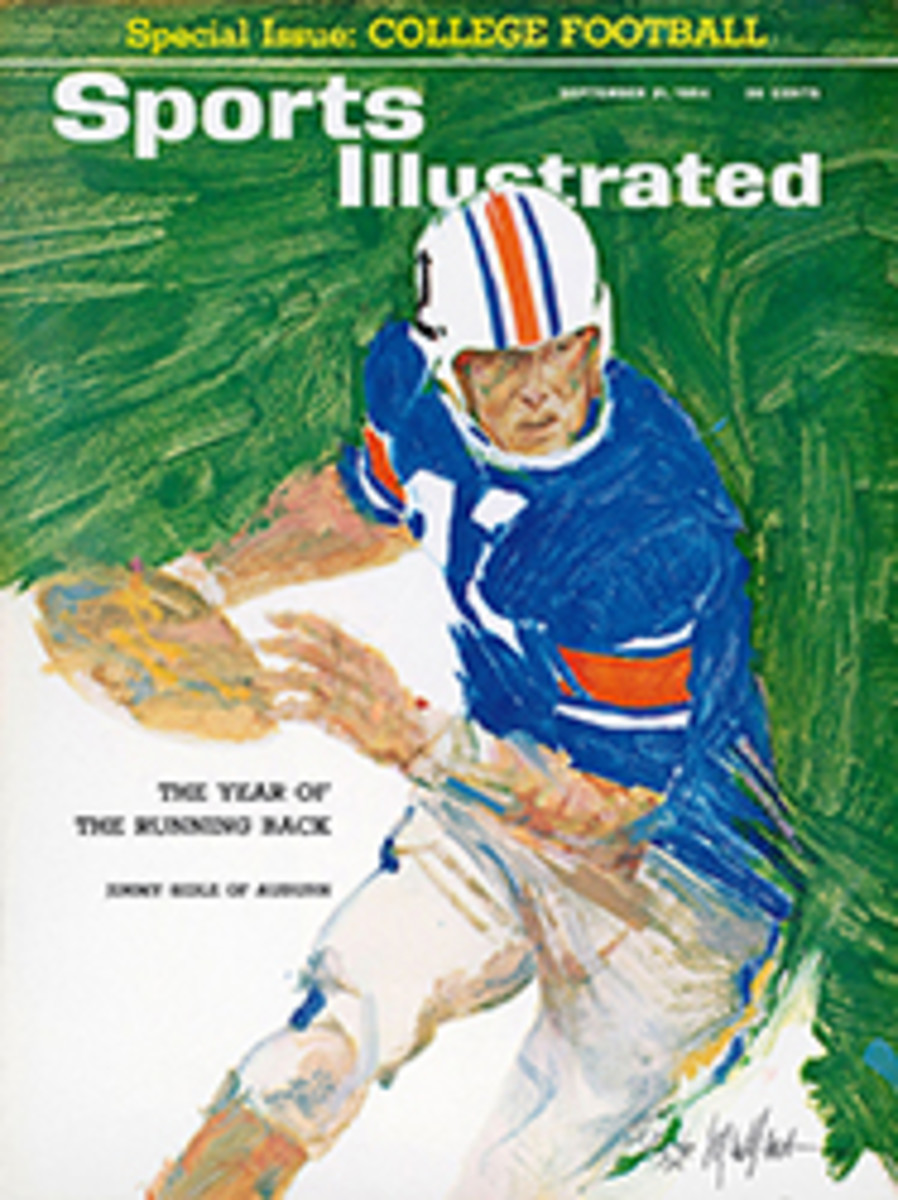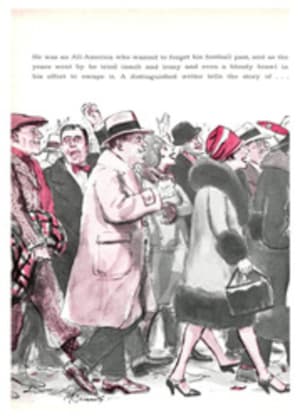
Pilot with Feet on the Ground
Robert Charles Gialdini is a champion stunt flier who never gets off the ground. He does daredevil tricks with model planes and was on the U.S. team at the recent world championships in model aviation in Budapest, Hungary. The contests were sponsored by the Fédération Aéronautique Internationale and included racing and stunt flying for teams as well as individuals. The American stunt-flying team won first place, with Russia second and Hungary third. In solo stunt flying Gialdini (in his first international competition) took third place, with the Russian and Finnish contestants ahead of him in that order.
At 32 Gialdini is a well-proportioned six-footer with an outgoing disposition and Italian good looks. He began flying models competitively at 15 at a club in Milwaukee. What had been child's play with fragile balsa models turned into a grown-up's avocation of designing and building intricate craft and taking part in the demanding sport of competitive flying. The stunt flying of model planes, also called precision aerobatics, requires a tremendous amount of skill. In competition, the pilot must send his model through a series of 14 prescribed maneuvers within a time limit of eight minutes. The stunts include wingovers, inverted flight, inside and outside loops (with round, square and triangular corners) and figure eights. These are executed at the end of two 65-foot control lines at speeds of 60 mph, with the planes swooping to within five feet of the ground. A wrong flip of the wrist or an errant wind current can bring disaster to a plane that took half a year and cost several hundred dollars to build. The judges in a contest watch each maneuver from takeoff to landing, scoring on a point system worked out by the Academy of Model Aeronautics. The A.M.A. is the official association for American competitive model airplaning.
Gialdini designs and builds his planes in a workshop in the basement of his Milwaukee home. One corner of the oak-finished basement is a sort of shrine to Gialdini models—a section decorated with trophies he has won at meets and with photographs of various planes, including the model he now uses, which he calls the Sting Ray. Tools, parts, and plans clutter the work table, and his now retired models are crammed into corners or hang on the walls like bat-shaped icons.
Modelers pamper their airplanes like fussy mothers. When they travel to meets in various parts of the country they pad and pack their models into trunks and special trailers with the care that might be afforded a Ming vase. "The planes travel in comfort," says Gialdini's wife, Joyce. "My clothes get tossed into the back seat." On the one or two occasions when Gialdini has traveled "by air to a competition, he has ridden with his plane on his lap rather than trust it to the baggage compartment. Ordinarily, however, Gialdini will drive rather than go by plane. "Flying makes me nervous," he says.
Competitive model airplanes deserve the delicate treatment they receive. They are crisply engineered craft. Like racing cars, the tethered planes always go around in circles, and the inboard wing is longer by several centimeters than the outboard one. Their jewellike, two-cycle engines, which operate on powerful nitromethane fuel, probably develop more horsepower per pound than any other engine built. A stunt plane weighs a mere three pounds but must display enormous strength. "We want our airplane to fly smoothly at 58 mph like it was tied to a rail," says Gialdini. "But we want it to turn 90° within seven feet. You generate a fantastic amount of lift going around such a corner—something like 300 pounds. It's like turning a flat plate in the wind."
Gialdini brings to his sport something of the same intensity that Miler Tom O'Hara brings to his. Beginning in—February, prior to the start of the summer competitive season, he swears off hard liquor in favor of beer to protect his reflexes, which must be razor-sharp. "We're working in hundredths of seconds," he explains. On the road as a salesman for General Motors' Diesel Engine Division, he packs his model in his car trunk. At the end of the day's appointments he heads for the nearest open field. Last year, in averaging 40 to 50 flights a week, he burned up 36 gallons of model-airplane fuel.
Modeling made a good Depression hobby. For a couple of pennies a boy could buy wood and a few sticks and build himself an airplane. In 1939, when Bob Gialdini was 7 and living in Portsmouth, Ohio, he acquired his first airplane engine. He and his two brothers used to fly model planes on the mud flats near the Ohio River until—in the interests of national security—they had to stop. When World War II arrived, air wardens began to scan the skies for enemy planes. A model airplane a few hundred feet overhead looked much the same as a real plane several thousand feet up, so free-flight flying was restricted. The sport might temporarily have died. Instead it received an unexpected boost when, in 1939, Jim Walker invented the present U-control line, which happily allowed modelers to keep their planes from flying off into the countryside.
In 1958 Gialdini entered for the first time the National Model Airplane Championships—held conveniently that year in Chicago. Admittedly green, he stood first in line to have his plane judged for appearance. The judges granted him 19 points out of a maximum of 40. Then the judges were switched. A second set of judges rerated his plane at 29 points, but it was too late. His score had been carded: he placed fourth by 9½ points.
He skipped the 1959 championships, held in California, but in Dallas the following year he made the highest score in the qualifying rounds. Five men each from two qualifying circles on Thursday make the Friday finals. Gialdini remembers those finals with pain: "I was so shook up that in my morning flight I did two inside loops instead of three. That cost me 26 pattern points. In the afternoon flight I did four outside loops instead of three. The judges didn't catch it, but my wife did, so when I turned in my score I told them they had made a mistake." A plaque now gracing the Gialdini basement wall proclaims him the best sportsman of the show, but someone else took home the first-place trophy.
In Philadelphia the next year Bob's luck seemingly had improved. He drew the last flying position, ordinarily the one he covets. In addition to the last spot's obvious competitive advantage, he figures that if the judges are going to loosen up they will do so toward the end of the day. In addition, wind conditions become more stable toward sundown. The U.S. Navy hosts championships each year on one of its stations and supplies judges—usually flying officers. For the most part, they make up in objectivity what they may lack in contest experience. But in 1961 the station commander chose the judges by volunteering a bunch of boot trainees who were about as interested in model air-planing as in K.P.
It was 5 p.m. when Gialdini made his last flight, but it was one of his best ever. The other competitors gathered around to congratulate him on his probable victory. But the day had been long, and the cards of the judges, who were then already speeding into town on passes, placed Bob third. "They had left before my plane had even stopped rolling," Bob ruefully remembers. "I don't think they even saw my landing. In 1962 Bob banged up his old reliable plane two weeks before the championships. A newly built version of the same model flew with the maneuverability of a mattress, so he had to abandon it. After a series of broken propellers and further difficulties with the old patched-up model, Gialdini placed fifth. He returned home disgusted. Abandoning the twin-tailed "Olympic" model which he had flown successfully in competition for four years, he designed a completely new plane with a forward cockpit and a tail like a jet. He anticipated a year's wait adjusting to the new plane. But in 1963 he won with it in open competition at the championships, then returned on the final day of the week-long meet to compete with the winners of the junior (under 16) and senior (under 21) divisions. He beat them and won the Jim Walker Trophy, symbolic of the all-round championship.
After years of patiently building planes and perfecting the techniques of flying them, Gialdini concludes that winning entails a good deal more than merely putting a plane through a series of intricate maneuvers. "It's not always the best stunt flier who wins," he says. "It's a combination of things, the general impression you leave. Besides your ability to fly, there are other considerations. How well does the plane fly? How does the plane look in the air to the judges? Does it look smooth? Does it have appealing lines? How do you look to the judges? How do you handle yourself around the circle? Are you a pain in the neck? Do you give civil answers to questions? All of these things add up to an impression. You don't get points for it, but it still affects your score."
Gialdini is so sensitive about the effect his actions as a whole may have on judges that, unlike most contestants, he refuses to turn his plane upside down to fuel it. He fuels and starts it while it sits on the runway. "If you're at an actual airport," he points out, "they don't flip the plane over to start it. I like to think of models as miniature planes, not toys. It might make a good impression on the judges." The theory seems to have worked for Gialdini.
PHOTO
IN CELLAR WORKSHOP, GIALDINI PUTS FINISHING TOUCHES ON ONE OF HIS MODELS
PHOTO
GIALDINI LAVISHES CARE ON A MODEL PLANE THAT HAS CRASHED DURING COMPETITION

